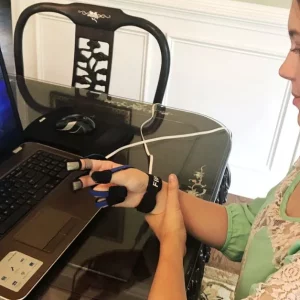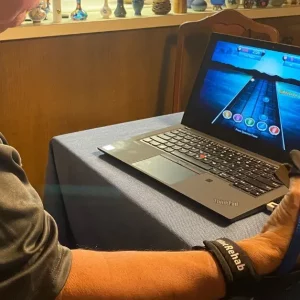Electrical stimulation for stroke patients offers a wide range of benefits. From improving motor skills to preventing atrophy, electrical stimulation can help you overcome many secondary effects of stroke. This modality can even be used to assist with conditions like foot drop after stroke or help manage painful symptoms.
If your physical or occupational therapist has recommended electrical stimulation, you might be wondering what this treatment entails. To help you better understand, we will start by explaining how electrical stimulation works and the various ways it can be used for stroke recovery. Additionally, we will review the different types of electrical stimulation you may encounter during rehabilitation.
Before getting started, it’s important to note that there are some contraindications for the use of electrical stimulation. This means electrical stimulation should not be used for certain individuals or conditions. These contraindications are as follows:
- Anyone with a pacemaker or other implanted electrical device should never use electrical stimulation as this could interfere with the device.
- Anyone with numbness or decreased sensation should use e-stim with extreme caution and under the direct supervision of a therapist or other health professional.
- E-stim should never be used over open wounds, tumors, or over the front of the neck.
- Pregnant women and individuals with epilepsy should consult a physician before using electrical stimulation.
While you may not have any of these contraindications, it is still important to speak with your therapist before starting electrical stimulation. They will be able to explain the treatment and show you the correct pad placement and settings. With that said, let’s discuss the mechanisms and benefits of electrical stimulation for stroke recovery.
How Does Electrical Stimulation for Stroke Patients Work?
To understand how electrical stimulation works, it will help to review how stroke affects your muscles. The brain uses chemical and electrical signals to tell your muscles when to move. When a stroke occurs, the damaged parts of the brain can no longer send these signals properly. As a result, it can become difficult, if not impossible, to move your affected muscles. This is where electrical stimulation (e-stim) can help.
Electrical stimulation works by placing non-invasive electrodes on your skin. Once activated, these electrodes send mild electrical impulses to your muscles, causing them to contract. This stimulation can be adjusted to increase or decrease muscle contraction, depending on the specific needs of the individual.
Electrical stimulation for stroke patients can help to activate the damaged portions of the brain by providing input to the affected neural pathways. In turn, this stimulation engages neuroplasticity, the process the brain uses to rewire itself and heal from injuries like stroke.
Neuroplasticity allows healthy areas of the brain to take over functions from areas of tissue damage. It does this by forming new neural pathways in response to stimulation. Therefore, the stimulation provided by e-stim can boost neuroplasticity and potentially speed up stroke recovery. However, this is not simply a passive treatment. To get the maximum benefits from electrical stimulation survivors must be active participants in this treatment, which we will discuss next.
How to Maximize Benefits from E-stim for Stroke Rehabilitation
One study by the American Heart Association found that combining electrical stimulation with physical therapy was more effective for stroke patients than exercise alone. Additionally, another study saw greater improvements in foot drop when electrical stimulation and therapy were combined. This illustrates how e-stim is most effective for stroke patients when used in conjunction with other rehab techniques.
While some forms of electrical stimulation are passive (involving no participation on your behalf), e-stim for stroke patients should be active. This means you should try to engage your muscles yourself when you feel the electrical current activate. When patients are engaged in therapy exercises during e-stim, this further engages the brain-muscle connection. Subsequently, this can increase the amount of motor control you are able to gain back.
Exercise without electrical stimulation will still activate neuroplasticity and help stroke patients regain movement. However, combining e-stim with exercise can be a great way to treat many different secondary effects of stroke to see the maximum benefits. Remember, it’s important to work alongside a therapist when starting with electrical stimulation.
Physical therapists will often use e-stim for rehabilitation of the lower extremities, while occupational therapists will use it for the arms and hands. These specialists know the best places to place the electrodes and which exercises are most helpful while stimulation is taking place. Additionally, they can tailor your exercises to make them more meaningful to you and to help you reach your own specific goals.
If e-stim works well for you, ask your therapist to recommend a home e-stim device along with exercises you can practice at home. E-stim is sometimes uncomfortable, but should never be painful. If you experience pain, ask your therapist to adjust your settings.
Types of Electrical Stimulation
There are multiple types of electrical stimulation available for use in stroke rehabilitation. These can be used for a variety of different secondary effects, which we will discuss later in this article. First, let’s review the most common types of e-stim used by therapists:
- Neuromuscular electrical stimulation (NMES). NMES involves sending electrical impulses to the muscles to imitate the signals normally sent from the nervous system. These impulses cause the targeted muscle to contract. NMES can be used for muscle strengthening and motor recovery of paralyzed or weakened limbs.
- Functional electrical stimulation (FES). This is a type of NMES that is commonly used in stroke rehabilitation. This involves e-stim combined with a functional movement, such as lifting the foot for walking to help reduce foot drop. It can also be used for contracting the fingers to help a survivor grasp an object. FES can help survivors regain functional use of their muscles for daily tasks and improve their quality of life.
- Transcutaneous electrical nerve stimulation (TENS). This type is often used to treat and manage post stroke pain. Instead of causing muscle contraction, TENS sends impulses to nerve cells to block pain signals. This feels like a tingling sensation and helps prevent pain messages from reaching the brain.
- Interferential current (IFC). IFC is very similar to TENS and is also used for pain reduction. IFC utilizes a different frequency and is sometimes a more comfortable treatment for patients compared to TENS.
While there are more types of electrical stimulation utilized by stroke patients, these are some of the main types commonly seen in rehab. By combining these types of e-stim, therapists can treat a wide range of stroke symptoms. Next, let’s discuss the different conditions that electrical stimulation can be used to treat.
Benefits of Electrical Stimulation for Stroke Patients
Since there are so many different types of electrical stimulation, there are also many different stroke secondary effects this modality can be used to treat. Uses of e-stim include strengthening muscles, managing pain, and improving functional movements. To help you better understand this, let’s discuss the different uses of electrical stimulation for stroke patients:
1. Hemiplegia and Hemiparesis
Many stroke patients experience hemiparesis or hemiplegia after stroke, referring to weakness or paralysis on one side of the body. E-stim can be used to address this by sending electrical impulses to introduce movement into paralyzed muscles after stroke (hemiplegia). This stimulation can help activate and rewire lost neural connections through the process of neuroplasticity.
By activating the paralyzed muscles and engaging your nervous system, you can increase the effectiveness of your paralysis recovery exercises to help rewire the brain. Ideally, through massed practice, this can help stroke patients with paralysis slowly regain movement. Stimulating your muscles regularly will also help prevent muscle atrophy, referring to the progressive weakness that is a common complication of stroke.
E-stim can also be an incredibly beneficial treatment for hemiparesis, or weakness of one side of the body after stroke. As discussed above, combining electrical stimulation with physical and occupational therapy exercises can help you increase your strength and maximize your rehab gains.
2. Spasticity and Gait (Walking)
E-stim has been shown to help reduce spasticity in stroke patients, even after a massive stroke. It works by restoring communication between the brain and the spastic muscles, which helps the muscles relax and lengthen.
Stroke patients who wish to improve their balance and gait can also benefit from electrical stimulation. With the help of a physical therapist, electrical stimulation can be used to help survivors practice proper gait techniques. Through this, you can boost neuroplasticity and help improve movement patterns.
Some therapists might also combine electrical stimulation with specialized equipment such as an assistive treadmill. This treadmill comes with a harness that supports you in a standing position to reduce the effects of gravity. A team of therapists can then help your legs move in a walking motion as the treadmill runs. Simultaneously, electrical stimulation can send signals to the muscles involved in walking to improve motor relearning.
3. Shoulder Subluxation
Due to weakness of the arm and shoulder muscles after stroke, some stroke patients may experience shoulder subluxation. This occurs when the arm becomes partially dislocated from the shoulder socket, which can be painful for the survivor.
Studies have found that functional electrical stimulation can reduce the severity of shoulder subluxation and the associated pain. This can help improve the function of the arm and make a survivor more independent with daily tasks. Additionally, other treatments can help address shoulder subluxation including braces or slings and shoulder exercises.
4. Edema (Swollen Limbs)
Electrical stimulation can help address sensory issues and may also be used to reduce edema after stroke. Edema is the buildup of excess fluid in the body’s tissues and is especially common in stroke patients with mobility impairments. This is often the result of decreased movement or blockage of the body’s lymphatic system after stroke.
When muscles are inactive for too long, they cannot help move fluid through the lymphatic system. As a result, this fluid can collect in the limbs, causing edema, pain, and stiffness. If it is not addressed, edema can continue to worsen and cause additional complications.
Thankfully, electrical stimulation can help reverse this by contracting the muscles and promoting the movement of fluid through the body. This prevents edema from occurring and can work to restore functional movement in the affected limbs.
5. Swallowing Problems (Dysphagia)
In addition to the limbs, the muscles necessary for speech, swallowing, and facial movements can also be affected by stroke. When survivors experience swallowing difficulties after stroke, this is referred to as dysphagia. If not addressed, dysphagia can lead to additional complications like malnutrition or aspiration pneumonia.
With the help of a highly trained therapist, however, electrical stimulation can be used to improve swallowing for stroke survivors. It’s critical to work with a therapist in this situation. Do not attempt to do this yourself as e-stim on the neck can be dangerous if not performed correctly. In these situations, it is necessary for a skilled therapist to safely place the electrodes on the appropriate muscles.
Risks of Electrical Stimulation
While electrical stimulation offers many benefits, it is not appropriate for all stroke patients. Earlier in this article, we discussed different contraindications for the use of e-stim. For example, this treatment can be dangerous for patients with implanted electrical devices such as a pacemaker or defibrillator.
In addition to contraindications for use, there are also some potential risks of using e-stim. Possible negative effects include muscle tears, skin irritation, and burns. These complications can occur for various reasons, such as a skin allergy or setting the intensity of the treatment too high.
Finally, there are different areas of the body that should be avoided when performing electrical stimulation. It is important to avoid placing the electrodes in inappropriate places such as over the:
- Eyes
- Heart
- Reproductive organs
- Exposed metal, such as pins or staples
Work closely with your rehab team to ensure e-stim is a safe option for you. They can determine if you should work alongside a therapist or if you can learn to safely use electrical stimulation independently at home. If you are safe to perform this treatment at home, your physical or occupational therapist will teach you the appropriate location and settings for your e-stim unit.
Is Electrical Stimulation Right for You?
Electrical stimulation is a versatile treatment that can be used to help manage a variety of stroke secondary effects. For example, e-stim offers promising benefits such as improved mobility, increased sensation, and pain reduction. It also boosts neuroplasticity in the brain to help rewire neural pathways and maximize recovery.
Remember, combining electrical stimulation with therapy exercises is critical for achieving the greatest results. Work alongside your therapy team to determine how this treatment can help you reach your unique goals. Your therapist can help ensure your safety by administering the treatment appropriately and targeting the desired muscles. Additionally, your therapist may be able to train you on how to safely use e-stim at home.
We hope this guide has helped inform you about the different uses of electrical stimulation for stroke patients. This can be a valuable addition to many survivors’ rehabilitation programs and can help boost the recovery process. Most importantly, it is vital to stay consistent and keep pursuing progress, one day at a time.









